‘Prosumers’ have the potential to shift and disrupt the energy landscape
This article has been supplied as a media statement and is not written by Creamer Media. It may be available only for a limited time on this website.
By Seydou Kane, Managing Director Africa, Eaton’s Electrical Sector
Modernising the current energy infrastructure in South Africa will dramatically change the energy utility business model, as industrial and private energy consumers now have access to technology that allows them to produce, store and distribute energy.
Parties that are able to do this are known as ‘prosumers’ – producer-consumers – and they could be manufacturers, businesses, or groups of consumers that have the potential to cause a shift in the structure of the energy industry.
At present, energy is mostly unidirectional: Eskom produces electricity, which is then distributed and sold to industrial, commercial and residential consumers, either directly or via municipalities. Post-lockdown, as businesses emerge into an environment still threatened by the prospect of load-shedding and extreme energy price increases, many are likely to consider going ‘off-grid’, or at least, finding ways to supplement their power needs with renewable energy resources.
This creates the opportunity for a major shift, with the possibility that the electricity network and grid will evolve in such a way that individuals or companies will be able to receive or resend energy to the grid. This is a shift in the structure of the industry, creating the scope for bidirectional flows of energy, where individuals or companies can both draw energy from the grid at a cost, or send energy into the grid, in return for payment.
While there is a tendency to believe that the most natural likely prosumers would be individuals with solar panels at their residence, it is likely that larger users like manufacturing sites could do the same. It’s even plausible that residential estates could look to installing their own microgrids, to create more resilience in the face of the power utility’s inconsistencies – a microgrid energy system provides a reliable, efficient and sustainable solution to overcome unexpected power loss.
This has come about because of a power shift where consumers - residential and commercial – are taking accountability and responsibility back, and the hardware and technology in South Africa exists for them to go off-grid if they want to. Indeed, South Africa has the most sophisticated grid and energy market on the African continent, and what happens here will lead continental trends in the decentralisation, decarbonisation and the digitalisation of energy.
The most important development that has made this shift possible is that energy storage costs have dropped by up to 90% in the last eight years or so, mainly driven by the adoption of electric vehicles, lithium ion batteries and nickel manganese chrome, used in electronics.
Apart from dramatic drops in costs, batteries have evolved to have a much smaller footprint, and they weigh less than before too, despite having a greater capacity.
From a software point of view, battery management systems (BMS) have evolved to include more capacity for artificial intelligence (AI), so that the system monitors and learns users’ behaviour. The system then adapts its energy generation and storage behaviour to align with user patters, to optimise for cost and capacity. Developers have also focused on improving the overall safety of these systems.
The big challenge that South Africa faces is how the monopoly utility and municipalities will adapt to this change, because prosumers have what they need to operate. The big challenge is that Eskom is R450bn in debt, and municipalities that need to balance Eskom and end user requirements, complicated by the fact that the utility is not able to provide enough energy when required.
The key question for the future is how will utilities like Eskom survive if industries and homeowners are able to go off grid – and even sell their surplus energy to one another? A utility’s success is based on its ability to plan its generation to meet demand – so how will they evolve once energy consumers are able to do as they please?
Power is fundamental to create jobs, for a country to develop, to grow – access to power is one of the key requirements for any economy to progress. If a community cannot access power, it’s first response is going to be trying to identify an alternative means of generating that power.
In our role as a power management company, Eaton is agnostic as to where power comes from, but we remain intrigued by the different sources of energy, different types of energy storage solutions, and the technology required to manage them. It is indeed an exciting time to play a role in South Africa’s energy future.
Comments
Press Office
Announcements
What's On
Subscribe to improve your user experience...
Option 1 (equivalent of R125 a month):
Receive a weekly copy of Creamer Media's Engineering News & Mining Weekly magazine
(print copy for those in South Africa and e-magazine for those outside of South Africa)
Receive daily email newsletters
Access to full search results
Access archive of magazine back copies
Access to Projects in Progress
Access to ONE Research Report of your choice in PDF format
Option 2 (equivalent of R375 a month):
All benefits from Option 1
PLUS
Access to Creamer Media's Research Channel Africa for ALL Research Reports, in PDF format, on various industrial and mining sectors
including Electricity; Water; Energy Transition; Hydrogen; Roads, Rail and Ports; Coal; Gold; Platinum; Battery Metals; etc.
Already a subscriber?
Forgotten your password?
Receive weekly copy of Creamer Media's Engineering News & Mining Weekly magazine (print copy for those in South Africa and e-magazine for those outside of South Africa)
➕
Recieve daily email newsletters
➕
Access to full search results
➕
Access archive of magazine back copies
➕
Access to Projects in Progress
➕
Access to ONE Research Report of your choice in PDF format
RESEARCH CHANNEL AFRICA
R4500 (equivalent of R375 a month)
SUBSCRIBEAll benefits from Option 1
➕
Access to Creamer Media's Research Channel Africa for ALL Research Reports on various industrial and mining sectors, in PDF format, including on:
Electricity
➕
Water
➕
Energy Transition
➕
Hydrogen
➕
Roads, Rail and Ports
➕
Coal
➕
Gold
➕
Platinum
➕
Battery Metals
➕
etc.
Receive all benefits from Option 1 or Option 2 delivered to numerous people at your company
➕
Multiple User names and Passwords for simultaneous log-ins
➕
Intranet integration access to all in your organisation





















